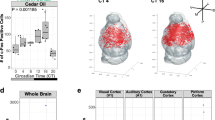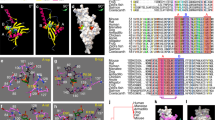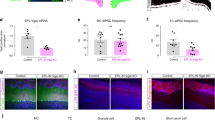Abstract
In the nose, odorants are detected on the cilia of olfactory sensory neurons (OSNs), where a cAMP-mediated signaling pathway transforms odor stimulation into electrical responses. Phosphodiesterase (PDE) activity in OSN cilia has long been thought to account for rapid response termination by degrading odor-induced cAMP. Two PDEs with distinct cellular localization have been found in OSNs: PDE1C in the cilia and PDE4A throughout the cell but absent from the cilia. We disrupted both of these genes in mice and carried out electro-olfactogram analysis. Unexpectedly, eliminating PDE1C did not prolong response termination. Prolonged termination occurred only in mice that lacked both PDEs, suggesting that cAMP degradation by PDE1C in cilia is not a rate-limiting factor for response termination in wild-type mice. Pde1c−/− OSNs instead showed reduced sensitivity and attenuated adaptation to repeated stimulation, suggesting that PDE1C may be involved in regulating sensitivity and adaptation. Our observations provide new perspectives on the regulation of olfactory transduction.
This is a preview of subscription content, access via your institution
Access options
Subscribe to this journal
Receive 12 print issues and online access
$209.00 per year
only $17.42 per issue
Buy this article
- Purchase on Springer Link
- Instant access to full article PDF
Prices may be subject to local taxes which are calculated during checkout







Similar content being viewed by others
References
Firestein, S., Shepherd, G.M. & Werblin, F.S. Time course of the membrane current underlying sensory transduction in salamander olfactory receptor neurones. J. Physiol. (Lond.) 430, 135–158 (1990).
Lowe, G. & Gold, G.H. The spatial distributions of odorant sensitivity and odorant-induced currents in salamander olfactory receptor cells. J. Physiol. (Lond.) 442, 147–168 (1991).
Firestein, S. How the olfactory system makes sense of scents. Nature 413, 211–218 (2001).
Ma, M. Encoding olfactory signals via multiple chemosensory systems. Crit. Rev. Biochem. Mol. Biol. 42, 463–480 (2007).
Kurahashi, T. & Yau, K.W. Co-existence of cationic and chloride components in odorant-induced current of vertebrate olfactory receptor cells. Nature 363, 71–74 (1993).
Kleene, S.J. Origin of the chloride current in olfactory transduction. Neuron 11, 123–132 (1993).
Lowe, G. & Gold, G.H. Nonlinear amplification by calcium-dependent chloride channels in olfactory receptor cells. Nature 366, 283–286 (1993).
Reisert, J., Bauer, P.J., Yau, K.W. & Frings, S. The Ca-activated Cl channel and its control in rat olfactory receptor neurons. J. Gen. Physiol. 122, 349–363 (2003).
Firestein, S., Darrow, B. & Shepherd, G.M. Activation of the sensory current in salamander olfactory receptor neurons depends on a G protein–mediated cAMP second messenger system. Neuron 6, 825–835 (1991).
Boekhoff, I. & Breer, H. Termination of second messenger signaling in olfaction. Proc. Natl. Acad. Sci. USA 89, 471–474 (1992).
Yan, C. et al. Molecular cloning and characterization of a calmodulin-dependent phosphodiesterase enriched in olfactory sensory neurons. Proc. Natl. Acad. Sci. USA 92, 9677–9681 (1995).
Yan, C., Zhao, A.Z., Bentley, J.K. & Beavo, J.A. The calmodulin-dependent phosphodiesterase gene PDE1C encodes several functionally different splice variants in a tissue-specific manner. J. Biol. Chem. 271, 25699–25706 (1996).
Cherry, J.A. & Davis, R.L. A mouse homolog of dunce, a gene important for learning and memory in Drosophila, is preferentially expressed in olfactory receptor neurons. J. Neurobiol. 28, 102–113 (1995).
Juilfs, D.M. et al. A subset of olfactory neurons that selectively express cGMP-stimulated phosphodiesterase (PDE2) and guanylyl cyclase–D define a unique olfactory signal transduction pathway. Proc. Natl. Acad. Sci. USA 94, 3388–3395 (1997).
Conti, M. & Beavo, J. Biochemistry and physiology of cyclic nucleotide phosphodiesterases: essential components in cyclic nucleotide signaling. Annu. Rev. Biochem. 76, 481–511 (2007).
Borisy, F.F. et al. Calcium/calmodulin-activated phosphodiesterase expressed in olfactory receptor neurons. J. Neurosci. 12, 915–923 (1992).
Scott, J.W. & Scott-Johnson, P.E. The electroolfactogram: a review of its history and uses. Microsc. Res. Tech. 58, 152–160 (2002).
Song, Y. et al. Olfactory CNG channel desensitization by Ca2+/CaM via the B1b subunit affects response termination, but not sensitivity to recurring stimulation. Neuron 58, 374–386 (2008).
Leinders-Zufall, T., Ma, M. & Zufall, F. Impaired odor adaptation in olfactory receptor neurons after inhibition of Ca2+/calmodulin kinase II. J. Neurosci. 19, RC19 (1999).
Zufall, F. & Leinders-Zufall, T. The cellular and molecular basis of odor adaptation. Chem. Senses 25, 473–481 (2000).
Boccaccio, A., Lagostena, L., Hagen, V. & Menini, A. Fast adaptation in mouse olfactory sensory neurons does not require the activity of phosphodiesterase. J. Gen. Physiol. 128, 171–184 (2006).
Chen, C., Nakamura, T. & Koutalos, Y. Cyclic AMP diffusion coefficient in frog olfactory cilia. Biophys. J. 76, 2861–2867 (1999).
Kaupp, U.B. & Seifert, R. Cyclic nucleotide–gated ion channels. Physiol. Rev. 82, 769–824 (2002).
Reisert, J. & Matthews, H.R. Na+-dependent Ca2+ extrusion governs response recovery in frog olfactory receptor cells. J. Gen. Physiol. 112, 529–535 (1998).
Willoughby, D. & Cooper, D.M. Live-cell imaging of cAMP dynamics. Nat. Methods 5, 29–36 (2008).
Leinders-Zufall, T. et al. Contribution of the receptor guanylyl cyclase GC-D to chemosensory function in the olfactory epithelium. Proc. Natl. Acad. Sci. USA 104, 14507–14512 (2007).
Hu, J. et al. Detection of near-atmospheric concentrations of CO2 by an olfactory subsystem in the mouse. Science 317, 953–957 (2007).
Wong, S.T. et al. Disruption of the type III adenylyl cyclase gene leads to peripheral and behavioral anosmia in transgenic mice. Neuron 27, 487–497 (2000).
Ma, M., Chen, W.R. & Shepherd, G.M. Electrophysiological characterization of rat and mouse olfactory receptor neurons from an intact epithelial preparation. J. Neurosci. Methods 92, 31–40 (1999).
Kurahashi, T. Activation by odorants of cation-selective conductance in the olfactory receptor cell isolated from the newt. J. Physiol. (Lond.) 419, 177–192 (1989).
Firestein, S. & Werblin, F. Odor-induced membrane currents in vertebrate-olfactory receptor neurons. Science 244, 79–82 (1989).
Wei, J. et al. Phosphorylation and inhibition of olfactory adenylyl cyclase by CaM kinase II in neurons: a mechanism for attenuation of olfactory signals. Neuron 21, 495–504 (1998).
Chen, T.Y. & Yau, K.W. Direct modulation by Ca2+-calmodulin of cyclic nucleotide–activated channel of rat olfactory receptor neurons. Nature 368, 545–548 (1994).
Kurahashi, T. & Menini, A. Mechanism of odorant adaptation in the olfactory receptor cell. Nature 385, 725–729 (1997).
Bradley, J., Reuter, D. & Frings, S. Facilitation of calmodulin-mediated odor adaptation by cAMP-gated channel subunits. Science 294, 2176–2178 (2001).
Munger, S.D. et al. Central role of the CNGA4 channel subunit in Ca2+-calmodulin–dependent odor adaptation. Science 294, 2172–2175 (2001).
Anholt, R.R., Aebi, U. & Snyder, S.H. A partially purified preparation of isolated chemosensory cilia from the olfactory epithelium of the bullfrog, Rana catesbeiana. J. Neurosci. 6, 1962–1969 (1986).
Zhao, H. et al. Functional expression of a mammalian odorant receptor. Science 279, 237–242 (1998).
Acknowledgements
We thank J. Beavo for antibody to PDE1C2, J. Cherry for antibody to PDE4A and F. Margolis for antibody to OMP. We also thank L. Brand, R. Cone, S. Hattar, R. Kuruvilla, T. Leinders-Zufall, R. Reed, J. Reisert and Y. Song for suggestions and comments on experiments and the manuscript, and members of the Hattar, Kuruvilla, Zhao laboratory for discussion. This work was supported by US National Institutes of Health National Institute on Deafness and other Communications Disorders grant DC007395.
Author information
Authors and Affiliations
Contributions
K.D.C. and H.Z. designed the experiments, K.D.C. collected the data, and both authors wrote the manuscript.
Corresponding author
Supplementary information
Supplementary Text and Figures
Supplementary Figures 1–5, Supplementary Tables 1 and 2, and Supplementary Note (PDF 3424 kb)
Rights and permissions
About this article
Cite this article
Cygnar, K., Zhao, H. Phosphodiesterase 1C is dispensable for rapid response termination of olfactory sensory neurons. Nat Neurosci 12, 454–462 (2009). https://doi.org/10.1038/nn.2289
Received:
Accepted:
Published:
Issue Date:
DOI: https://doi.org/10.1038/nn.2289
This article is cited by
-
The functional relevance of olfactory marker protein in the vertebrate olfactory system: a never-ending story
Cell and Tissue Research (2021)
-
The cyclic AMP signaling pathway in the rodent main olfactory system
Cell and Tissue Research (2021)
-
The Phenomenon of Compensatory Cell Proliferation in Olfactory Epithelium in Fish Caused by Prolonged Exposure to Natural Odorants
Scientific Reports (2020)
-
The BEACH Protein LRBA Promotes the Localization of the Heterotrimeric G-protein Golf to Olfactory Cilia
Scientific Reports (2017)
-
Advances in targeting cyclic nucleotide phosphodiesterases
Nature Reviews Drug Discovery (2014)



